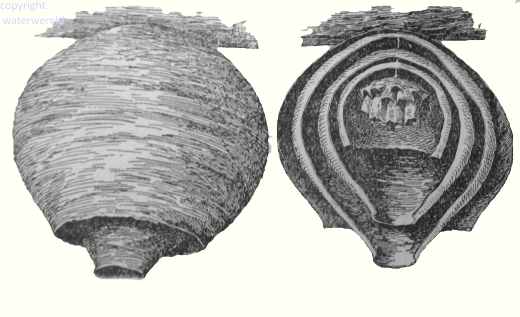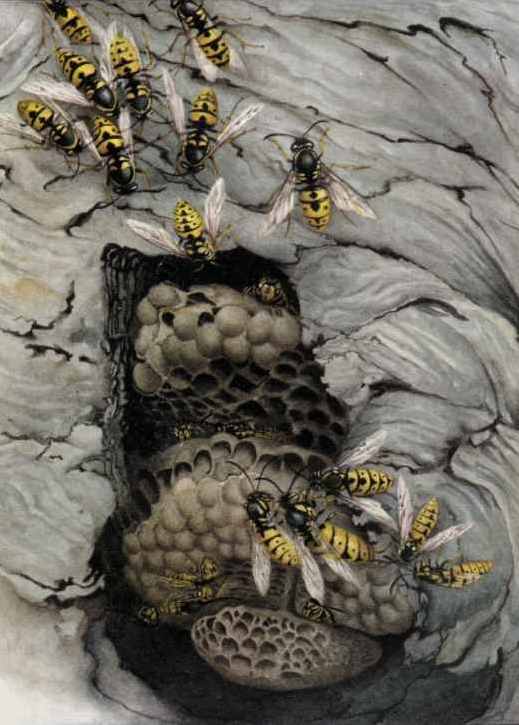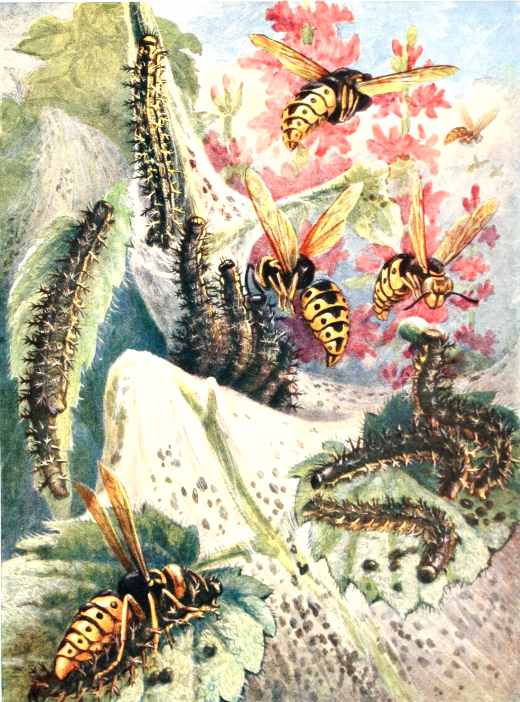the German wasp
This is an easy to see insect: it has warning signs: the black and yellow stripes.
The german wasp forms communities consisting of thousands of worker wasps,
who not only provide habination for their progeny,
but watch and nurse these for the moment they escape from the egg until they reached the winged stage,
preparing their food for them and actually putting it in their mouths.

The german wasp, vespula germanica
starting a colonie
In the fall, a new queens start to hibernate while the old queen die off.
The new young queens search for a warm, shelter to survive the winter:
Some remain in the nest, some look for a crevice.
In the spring the new queen will awake and leave the nest or shelter.
This foundress queen selects a hole to start the new colonie:
sometimes a hollow tree, wall cavity or rock crevice for a nest site.
the first grubs
The new queen catches some insects to feed the first batch of grubs.
The first batch of grubs will become full fed and spin a papary cab around it cells, throwing of its last grub skin and becomes a chrysalis.
It takes about four weeks from the moment the eggs were laid to emerge as a worker wasp from the cells.
These workers start to build to nurse the grubs, caterer and build. the german wasp during the summer
The queen has nothing to do anymore exept for laying eggs.
The amount of workers fastly increases. Males will only appear at the end of the summer, together with the new queens.
After the queen has died, there is nothing left for the worker wasps to do:
They have then very little time left until the autumn night frost will kill them.
These wesps will look for over ripe fruit and other sweet things like limonade.

The grey nest of german wasp consist of concentric layers of paper material. This will give isolation to cold temperatures: the german wasp is very sensitiv for frosty temperatures. The nest is very light in weight.

A German wasps nest. Source: E. J. Detmold: Fabre's Book of Insects.
wasp nuisance
Wasps are attracted to sugars, meat and food in general.
They are unwelcome guests at summer picnics and barbecues and are fond of limonade.
The venom from a wasp sting contains several toxins that can cause a hypersensitive or allergic reaction in 10% of the people.
The people who are allergic for wasp venom should carry a antihistamine tablets with them at all times.
wasp control
A nest of the german wasp can be easely destroyed. Do this only at night, by placing some poison in the nest entrance.
The in en out flying wasps will carry the poison into the nest. Mostly all the wasps are killed within two days .

The grubs in the combs of the of the Social wasp need to be constantly fed. To meet the enourmeos demand made upon them for fresh food the worker wasps wage an uncaesing war upon other insects. Here those worker wasps have found a community of caterpillars of the small tortoise-shell butterfly, crawling upon their tents and upon their nettle leaves. Those not to large are hauled to nest intact but thoose to heavy for carriage will be cut in pieces. The favorite food of social wasps are aphids.
There are many birds that kill wasps ocasionally, just a few will purposely hunt down wasps, such as starlings, blackbirds and magpies. Hornets kill bees and wasps for food. Predatory reptiles and amphibians don't seem to care that a wasp is capable of stinging.